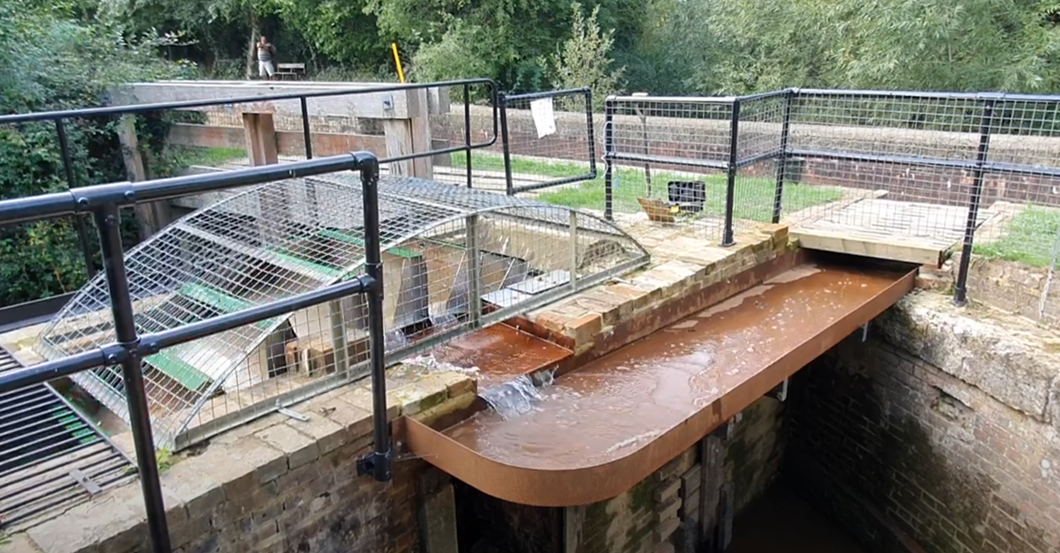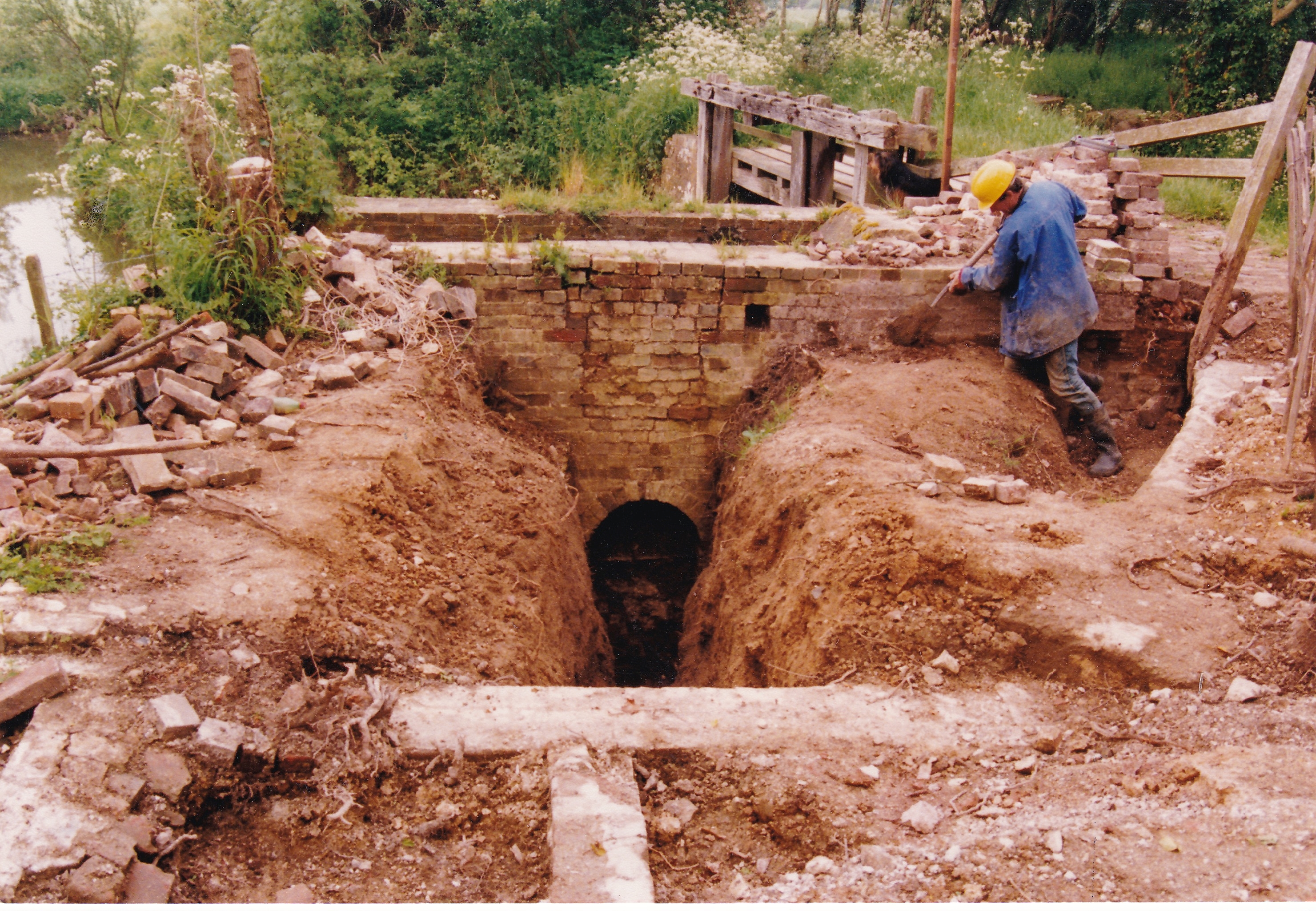
You are now at Lordings Lock and Aqueduct, one of the real engineering gems of the Arun Navigation which opened up to Newbridge in 1787. It is a combined structure with the three-arch aqueduct taking the canal across the River Arun and the lock raising the level of the canal by a few feet for its next stretch up to Newbridge.
Long after the old canal closed, the Southern Water Board, a predecessor to today’s Environment Agency, cut a new flood channel in the river and installed a new weir, helping to reduce flooding in the Arun Valley which happens on a regular basis. This new flood channel crosses the line of the old canal.
The Waterwheel and why it was built ?
Alongside the lock is a remarkable waterwheel, powered by the river below and designed to lift water from the river up into the canal to maintain water levels for 40 ton barges. For those technically minded, it is an undershot waterwheel called a ‘noria’.
The waterwheel is about 13 ft in diameter and located in a narrow brick chamber. A stream from the river can be opened to pass along the bottom of the wheel to activate rotation. As it turns, its 32 buckets pick up water entering from a separate stream and raise this water up about 9 ft where it is discharged down a chute into the lock on the canal.
Restoration
After closure of the old canal, Lordings Aqueduct suffered badly from flood damage. But from 1992 and over a period of ten subsequent years, restoration pioneer Winston Harwood and fellow volunteers in the Lordings Aqueduct Group painstakingly restored the old structure, extending the arches, repointing and providing much needed ‘TLC’. They can be proud of their work.

Restoration of the waterwheel proved even more of a challenge. The remains of the wheel housing was discovered in complete disrepair by Winston Harwood in 1992 while working on the aqueduct and there were no records of its original design – no one knew how it was supposed to work! But through excavations and some very clever detective work, Winston and his team formulated a design which fitted the clues in the wheel chamber and they built a new wheel which became operational in 2003, successfully transferring an impressive 1,800 gallons per hour.
In the same period, Winston’s team restored the lock ready for use when the canal reaches this spot sometime in the future.
However, following a spate of vandalism and general deterioration, the waterwheel again fell into disrepair. Coming to the rescue this time was Brian King, a retired mechanical engineer and a keen volunteer with the Wey and Arun Canal Trust (WACT). Brian found that the wheel’s central support bolts had sheared and the whole wheel had dropped onto the brick base. A new stainless steel shaft was manufactured with associated bearings and the wheel was again lifted into position. The entire wheel and chamber were rejuvenated and the new working wheel was commissioned in autumn 2022. The results were even more impressive this time round, lifting a remarkable 3,100 gallons per hour when running at 1.5 rpm. A great You Tube video has been made describing the restoration and showing the wheel in motion. You might like to take a look at: https://youtu.be/QEc925r6Kng
The wheel will be now regularly tested every few months and it is hoped that dates and times will be published through this QR code and also on the Wey and Arun web site: https://weyarun.org.uk/
Aside from the waterwheel, WACT is currently working on ideas for restoring the line of the canal across the new flood channel in the river and these will be exciting when they are published.
If you would like to be involved in other restoration projects along the length of the canal or in the general upkeep of this wonderful green corridor, take a look at the volunteers page on the Wey and Arun Canal Trust web site at https://weyarun.org.uk/backdrop/volunteering
Flora and Fauna
This wide-open landscape is home to a huge variety of flora and fauna. Deer can regularly be seen jumping along by Orfold Farm. In the spring, the woods up from Lordings and across to Guildenhurst Farm are full of bluebells, providing that mystical carpet of blue, dancing in the breeze. Look above you and you will often see a buzzard gliding past and kestrels or a heron happy to see water returning to these parts of the old canal.
- In spring, look out for cowslips and crosswort
- In summer, you may see common centaury or common cat’s-eat
- In autumn, large and hedge bindweed is commonly around.
Next information Posts
Heading south, our next Information Post is a couple of hundred yards along at the Lordings Flood Gates. On the way you will cross over the new flood channel of the River Arun which can flow fast and full following spells of heavy rain. You can see why the water authorities wanted a larger channel to clear this water from the flood plain as quickly as possible. Sometime in the future, WACT is aiming to restore the canal to follow its old line across where this flood channel has now been cut.
Heading north, the next Information Post is about 2 miles away at Northlands Lift Bridge. Immediately north from Lordings, the canal is conspicuous by its absence, having been filled in when the old canal closed and the land reverted to agricultural use. But it is in water again beyond Guildenhurst Bridge, then under the culverted Newbridge on the busy A272 and up to Northlands lift bridge and Rowner Lock, the site of WACT’s very first restoration work party in March 1971.
On the way along, you could even divert up to the Limeburners Arms who serve a good lunch and a decent pint. Enjoy!
A full list of Infomation Posts can be found here.
